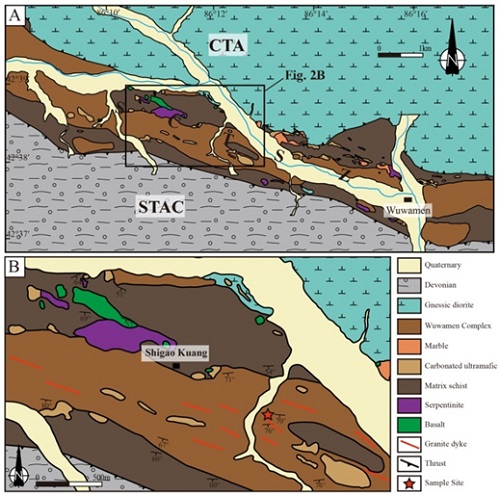The Central Asian Orogenic Belt (CAOB) has drawn the attention of the international geoscience community over the past twenty years due to its distinct accretionary orogeny, prominent continental growth and large-scale metallogeny. A basic architectural controversy concerning the tectonic models of the CAOB has emerged and hampers our further understanding of orogenic mechanisms. Two contrasting models are proposed: (1) a long-lived, single subduction system, and (2) multiple subduction and accretion of archipelagic ocean. Previous research has mainly focused on the magmatism, ophiolites, high-pressure metamorphic rocks, and structural deformation. However, whether there are reliable indicators of ancient metamorphic basement in the CAOB, especially the basement and origin of the Central Tianshan Arc Terrane (CTA) in China, is still in debate, which is crucial to the reconstruction of the tectonic framework of the CAOB.
Doctoral candidate Mr. Xin-Shui Wang and his supervisor Prof. Jun Gao in Division of Solid Mineral Resources, Institute of Geology and Geophysics, CAS investigated the South Central Tianshan Ophiolitic Melange Belt and discovered high-grade metamorphic rocks in the belt. Based on detailed geological mapping, they determined the distribution and rock assemblages of the Wuwamen Complex, which represents the Precambrian basement relics of the CTA (Fig. 1). Geochronological and geochemical study of biotite-plagioclase-hornblende orthogneisses and intruding leucogranite dykes in the complex revealed that: (1) the CTA has late Archean to early Paleoproterozoic basement, (2) the CTA experienced ~2.5 Ga global continental growth, ~1.8 Ga global collisional orogenic event related to the assembly of Columbia and ~785 Ma crustal reworking associated with the breakup of Rodinia, and (3) the CTA was part of the Tarim Craton during the Precambrian based on stratigraphic correlation, magmatism, metamorphism and similarity of age spectra of detrital zircon grains (Fig. 2).
This study documented the existence of late Archean to early Paleoproterozoic basement in the CTA for the first time, and proposed a tentative tectonic framework integrated with geochronology of the CTA during the Precambrian. Furthermore, the study places constraints on the reconstruction of the tectonic model of the CAOB and metal source and metallogenic geodynamics of the large-scale metallogeny in the CAOB. This contribution was recently published in the international journal Precambrian Research (Wang, X-S. et al., 2014. Geochemistry and geochronology of the Precambrian high-grade metamorphic complex in the Southern Central Tianshan ophiolitic mélange, NW China. Precambrian Research, 254, 129–148).
Article Link

Fig. 1 The distribution of the Wuwamen Complex to the south of the CTA

Fig. 2 Comparison between the Tarim craton and the CTA featuring stratigraphy, magmatism, metamorphism, and age spectra of Precambrian detrital zircon grains.